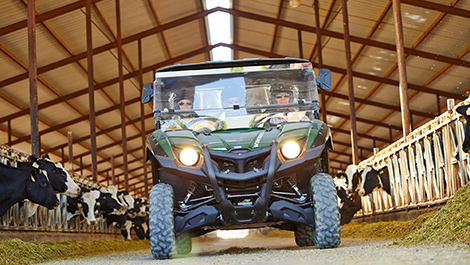Yamaha introduced its first side-by-side vehicle in 2004. The practical and fairly sporty Rhino soon caught the attention of trail enthusiasts. Ten years later, the Japanese manufacturer launches an all-new model with the same aspirations as its predecessor.
The 2015 Yamaha Viking stands out from the Rhino with a wider body defined by sharp, muscular lines as well as the brand's signature fit and finish.
 |
| Photo: Yamaha Motor |
Fancy a threesome?
The Viking can actually sit three normal people abreast. If you don't think that's impressive, you should take a look at the competition and their cramped bench seats. Here, the backrest of the middle seat is tilted 5 degrees farther than the driver and outside passenger backrests, creating an off-set seating position that allows all on board to comfortably fit without rubbing shoulders. I personally sat in the middle during a ride and I never felt squeezed.
Another interesting attribute of the 2015 Yamaha Viking is the partition that prevents the centre passenger’s feet from interfering with the driver's to aid in safe operation and a secure driving position. Occupants are protected by side panels, 3-point seat belts, and a 2” thick roof support covering their heads and solidifying the chassis.
Similar to the new, 6-passenger Viking VI, there's a problem with the design of the seat belt pretensioners, which accumulate sand, water and twigs, making them less effective. Short of a remedy by Yamaha, owners better be prepared to clean them and apply some lubricant on a regular basis to ensure proper operation.
A warrior with the heart of a wild bear
A liquid-cooled, 686cc, single-cylinder engine derived from the Grizzly motivates the 2015 Yamaha Viking. Engineers made a number of modifications, however, including a reshaped combustion chamber, revised compression ratio, new cam profile, forged piston, and larger airbox.
The engine is mounted under the cargo bed; you can tilt the latter for easy access and maintenance. Low-end torque matters more than top-end power, here, which is perfect for big, heavy duties. Still, this powerplant delivers solid acceleration. What's more, the few undesirable vibrations at idle disappear once you get up to speed. I found operational refinement quite impressive for a large single.
The slightest dip of the gas pedal is met with an immediate response thanks to Yamaha's renowned Ultramatic CVT, which uses a wet, centrifugal clutch inside the crankcase, away from the elements and debris. Power then goes through a drive pulley that maintains constant belt tension for sharper operation upon takeoff, increased effectiveness under load, and greater belt longevity than a traditional system.
The Ultramatic transmission also serves as an excellent engine brake in descents, and a driver-operated “on-command” mode selector (2WD, 4WD, 4WD Lock) allows for differential shifting based on changing road and ground conditions.
Despite being a utility vehicle first, the 2015 Yamaha Viking proves quite nimble especially with the available electronic power steering (EPS) which allows quick, effortless manoeuvres. On rocky terrain with lots of bumps, the ride feels a bit too stiff and out of control, but fortunately, you can adjust preload based on your driving style.
Bottom line
Clearly, the folks at Yamaha did their homework. Here we have a rugged, dependable, and nimble side-by-side vehicle with 4-wheel disc brakes and comfortable, 3-passenger seating. The
2015 Viking EPS will appeal to trail enthusiasts as much as serious workers.
Pros
- Three comfortable seats
- Powerful brakes
- Excellent CVT
- Ergonomic cabin with full floorboard
Cons
- Seat belt pretensioners are exposed to the elements
- Engine vibrations at idle
- Stiff ride

